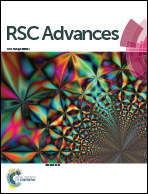An experimental and theoretical investigation into the self-assembly of a chemically modified high-χ coil–rod diblock copolymer†
Abstract
A precursor diblock copolymer with a silicon backbone, polystyrene-block-poly(methylvinylsiloxane), was synthesized, and 1H,1H,2H,2H-perfluorodecanethiol was quantitatively introduced into the backbone via a thiol-ene reaction to yield a novel coil–rod diblock copolymer, poly(styrene-block-poly(2-((3,3,4,4,5,5,6,6,7,7,8,8,9,9,10,10,10-heptadecafluorodecyl)thio)ethyl)methylsiloxane). The ultra-hydrophobicity of the introduced perfluoroalkyl side chain enhanced the segregation between counter-blocks and significantly increased the χ value, which is essential for minimizing the size of self-assembled domains for lithographic applications. Thus, self-assembled domains with a minimal spacing of approximately 10 nm were formed. A hexagonally packed array with significant anisotropy was observed in the self-assembled morphology by small-angle X-ray scattering and transmission electron microscopy. Such an array was precisely reproduced by modified self-consistent field theory (SCFT) calculation developed for the coil–rod structure. Furthermore, the phase diagram was estimated, and the morphological dependence on the relative scale of the rod unit was investigated by SCFT prediction.



 Please wait while we load your content...
Please wait while we load your content...